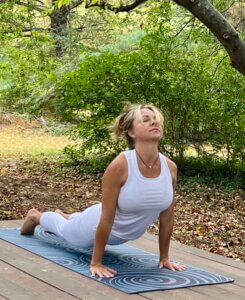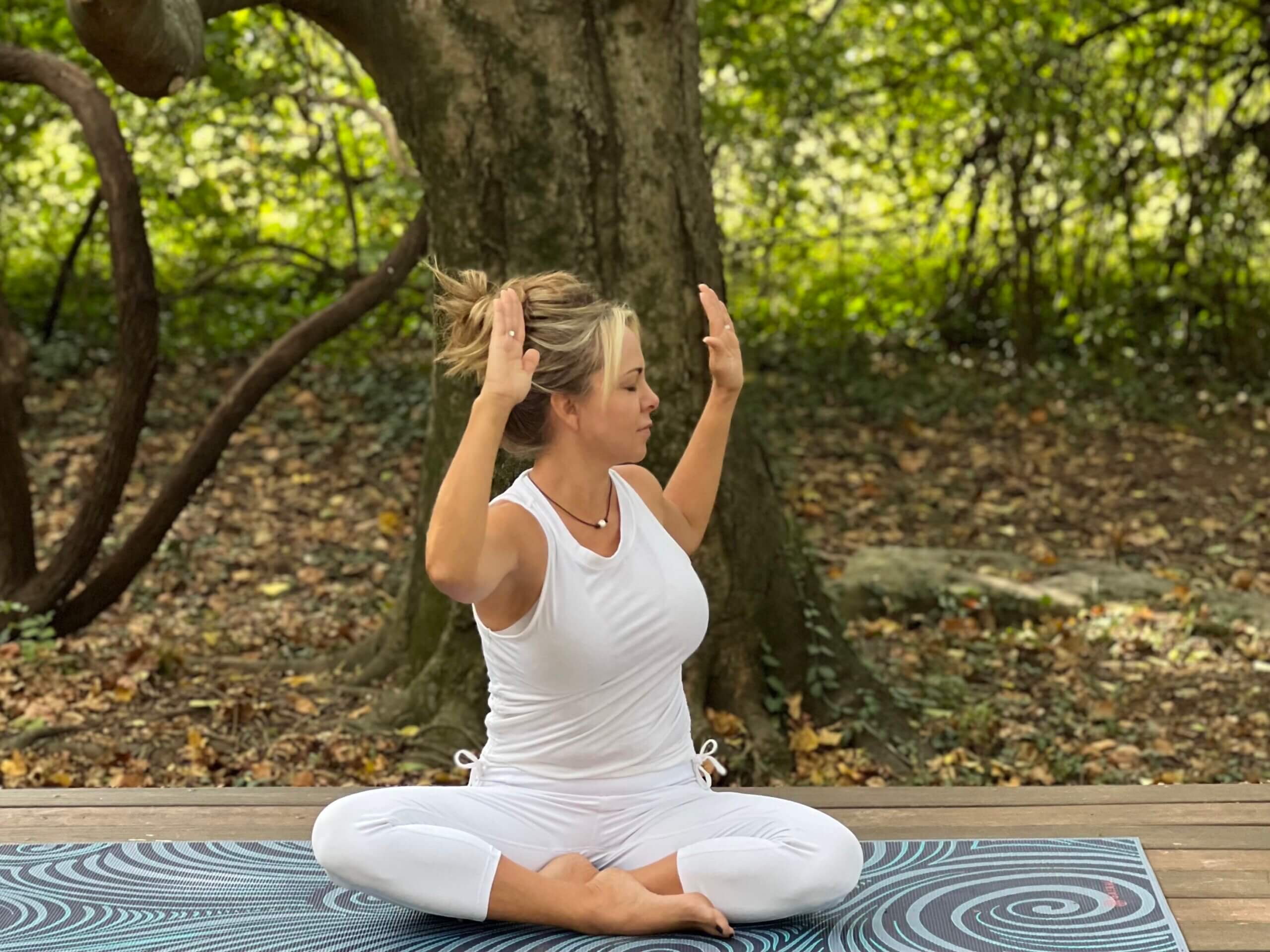It’s the fall of 2018 and I’m jogging in the park listening to Eckhart Tolle’s The Power of Now (again), and I begin praying: God, I need a teacher. A mentor. Someone to take me by the hand and lead me out of this darkness. It’s too big for me. I’m not strong enough. It starts to rain. And I open my arms, turn my face to the sky, and say over and over: Please hear me, God. Please.
Shortly thereafter a new yoga teacher arrives at the YMCA who teaches Kundalini Yoga. She’s also a reiki master, Christian mystic, and chats with the Vatican, but I don’t learn about all that until later.
The class begins with her belting out a deep and guttural stream of words that I don’t understand. I sit there uncomfortably on my mat unsure if I should be embarrassed or intrigued. The class continues with lots of twisting, sweeping arm movements, and strange breathing exercises she calls “Breath of Fire.”
I’m way out of my comfort zone in her class but she talks about activating our source of untapped energy and rising to higher levels of consciousness. By the end of the class, I decide I’m more intrigued than embarrassed and go back for several more of her classes.
Then, the dramas of life took me over once again and Kundalini Yoga faded into the background. The student wasn’t ready. Until now . . .
My main intention for 2022 is to learn how to go into a deep meditative state. To go beyond thought to the stillness and bliss of samadhi, or the state in which individual and universal consciousness unite. I’ve read about it and witnessed it, but never fully experienced it myself. This quest led me back to Kundalini Yoga.
Now, I’m in the midst of a powerful 6-month Kundalini Yoga Teacher Training (KYTT) program led by Guru Singh and Brett Larkin.
Here’s a glimpse of what Kundalini is all about, its benefits, and how you can try it for yourself.
What is Kundalini Yoga?
Kundalini dates back thousands of years and is believed to have originated in shamanic cultures in present-day India. For generations, the practice was only taught directly from Guru to student until it was brought to the West in the late sixties.
The term Kundalini comes from the root word Kunda — meaning coil; and lini — meaning line or nerve. Kundalini energy is believed to be coiled nerve ganglia at the base of the spine (symbolized as a coiled snake) which lies dormant until it is activated. Typically Kundalini energy is activated by tension, pressure, stress, and friction. The energy then rises up the spine through the chakras to the crown of the head and Self-Realization.

Difference between Kundalini and other types of yoga
First and foremost, all types of yoga were designed by the Sages and Brahmans ages ago for one purpose: to obtain higher consciousness and enlightenment. While we may practice yoga for better flexibility, tight buns, and toned arms, the physical benefits from postures like Downward Dog and Plank are only one branch of the eight limbs of yoga.
The eight limbs of yoga are like a map to the soul for us to achieve Self-Realization.
The limbs are intended to be mastered in succession, but it’s important to remember that samadhi or enlightenment can happen to us at any moment.
8 Limbs of Yoga
- Yamas — Guiding principles of what not to do: violence, lying, stealing, lack of self-control & excessiveness
- Niyamas — Guiding principles of what to do: purity, acceptance, discipline, self-study & reflection, devotion & surrender to something greater
- Asanas — Postures to prepare the body for long periods of meditation
- Pranayama — Breathing techniques to harness our breath or life force. The breath is the vehicle of our inner Self.
- Pratyahara — Mastering the outer senses of the body; going within
- Dharana — Focused concentration/mantra. Chanting or mantra helps override thoughts & the monkey mind
- Dhyana — Absorption in a meditative state. No thoughts, only connection to higher consciousness
- Samadhi — Unity consciousness, bliss, enlightenment.
The main difference between Kundalini Yoga and Vinyasa or Hatha Yoga is that Kundalini combines the physical and spiritual limbs of yoga into a set of practices called Kriyas. The Kriyas include mantras, postures, breathwork, mudras, and meditation.
Kriyas
Kriyas are designed to activate Kundalini energy, remove blocks within the chakras and allow the energy to flow like a circuit throughout the body.
Kriyas are also created to help target issues in everyday life, such as fatigue, stress, brain function, and memory. Some kriyas have been passed down for generations and some are newly created or adapted to fit the needs of the time.
Mantras
All kriyas begin with chanting a mantra or positive affirmation. Chanting demonstrates that everyone has a voice and we can use our voice to develop our own authority. The Adi Mantra is usually chanted in Gurmukhi to begin a kriya.
- Adi Mantra: Ong Namo Guru Dev Namo, which means, “I bow to the Divine Wisdom within myself and all of creation.”
Kriyas end with a long Sat Nam which means, “Truth is my essence.” One recognizes the truth or divinity within themselves and all beings.
Mudras
Mudras are symbolic gestures performed mainly with the hands and fingers to channel your body’s energy flow.
- The Gyan mudra is used frequently in Kundalini Yoga. You touch your index finger and thumb together to form a circle. The index finger represents the individual and the thumb represents universal consciousness. When the index finger bends towards the thumb it means one has surrendered to the divine/universal consciousness — the union of the self with the divine.
How can Kundalini Yoga benefit you?
Kundalini’s powerful meditations, postures, and breathing techniques are mainly focused on channeling the energy within us. But there are physical benefits as well. Personally, I feel better, look better, and notice positive changes to my body more when I’m consistently practicing yoga than any other exercise routine.
Research has shown that Kundalini Yoga can also help improve cognitive function. The US Alzheimer’s Research and Prevention Foundation recommends practicing the Kirtan Kriya for greater attention, concentration, focus, memory and better mood. Click the US Alzheimer’s link for detailed instructions to try Kirtan Kriya for yourself.
Kirtan Kriya is easy to do and it gives me a calm and centered feeling. I practice Kirtan Kriya while sitting in meditation, doing a walking meditation, or recently while waiting in long lines at Disney!
Is Kundalini a Path to Enlightenment?
Kundalini Yoga’s main focus is on elevating consciousness to enhance our awareness and move past our egos. To become leaders rather than followers of our thoughts and emotions. To become our own Gurus.
I haven’t had a mind-blowing meditation experience yet, but some of my group members have. I can honestly say that since beginning the Kundalini training, I have gained much more clarity, insight, and intuition. And I feel more connected with my higher Self.
The practice has gently yet firmly elicited discipline, strength, and determination from me. It helps take me away from the chatter of my mind to a deeper place within myself.
Quick Kundalini Practices to Try Yourself
TO BOOST ENERGY — Breath of Fire
INSTRUCTIONS:
- Sit cross-legged with your hands resting on your knees, tips of index finger and thumb touching.
- Close your eyes and internally gaze at the point between your eyebrows.
- On the inhale puff your lower belly out and on the exhale pull your navel back towards your spine. The main focus is on breathing into the lower belly.
- Continue puffing the belly in and as fast as you can without feeling light headed for 3-11 minutes.
- End with a deep inhale, hold the breath for as long as you comfortably can, and then deeply exhale.
TO BOOST SEXUAL ENERGY — Sat Kriya
INSTRUCTIONS:
- Sit on your heels
- Stretch the arms alongside the ears. Interlace the fingers except the index fingers. Fingers pointed toward the ceiling. Arms hug the ears. No bend in the elbows.
- Close the eyes and internally gaze at the point between your eyebrows.
- Inhale to begins, expanding your belly.
- Chant “SAT” powerfully on the exhale, pulling the navel toward the spine.
- Chant “NAM” on or before the inhale, releasing the belly again.
- Keep chanting “SAT” on the exhale, “NAM” on the inhale as you release the belly, creating a rhythm. (Sat Nam means truth is my essence or my true essence)
- Continue for 3-11 minutes.
- End with deep inhale and pull the navel back towards the spine, and then exhale.


